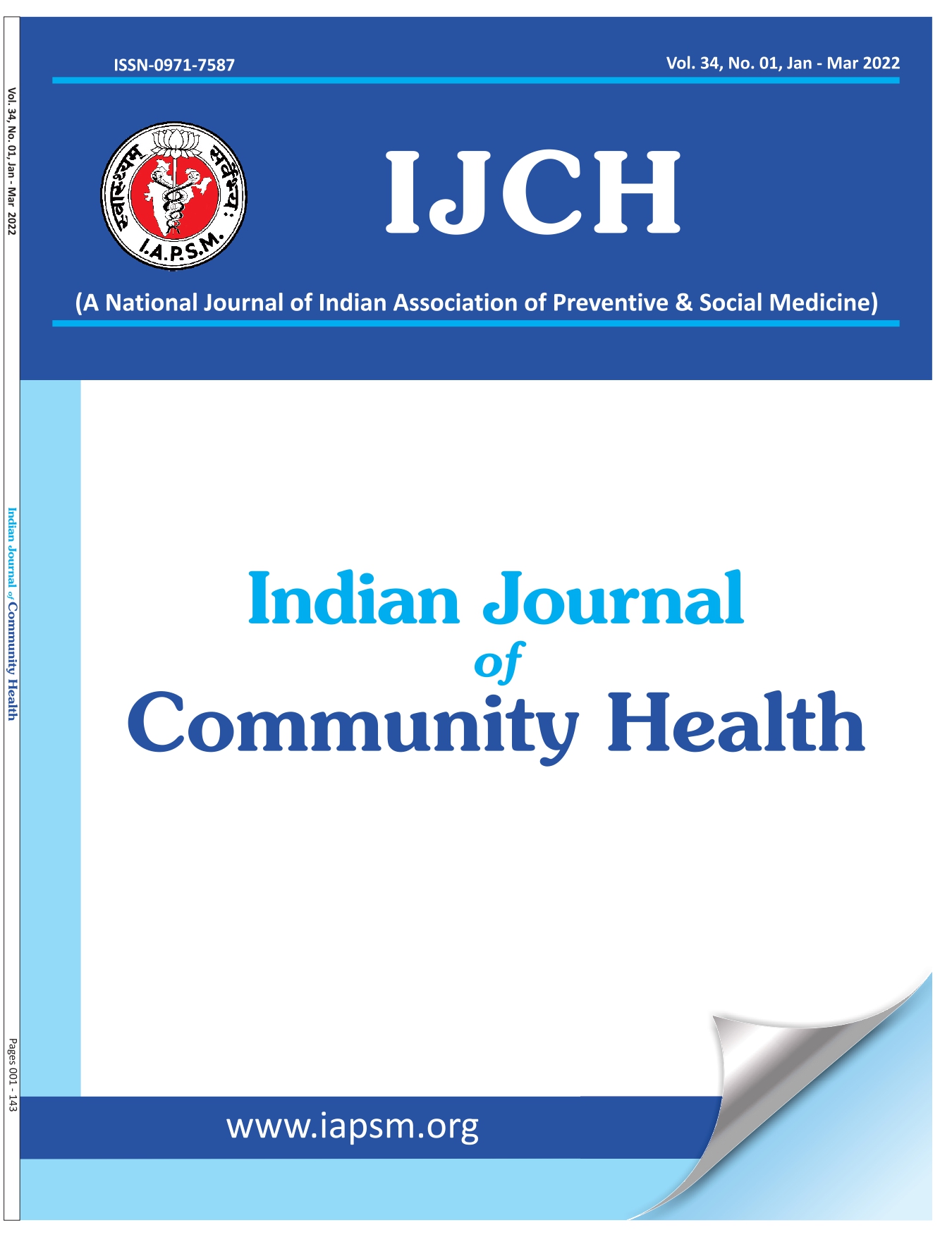Poor glycemic control and associated factors among Type 2 Diabetes Mellitus patients at a Tertiary Health Care facility
DOI:
https://doi.org/10.47203/IJCH.2025.v37i02.004Keywords:
Type 2 Diabetes Mellitus, Glycemic Control, Cross-Sectional Study, Socio-Demographic Factors, Dietary HabitsAbstract
Background: Poor glycemic control in type 2 diabetes mellitus (T2DM) patients is a major concern, as it can lead to serious complications. Understanding the factors contributing to poor glycemic control is essential for developing interventions to improve diabetes management and patient outcomes. Aim and Objective: This study aims to identify the factors associated with poor glycemic control among T2DM patients attending a tertiary health care facility. Setting and Design: A cross-sectional study was conducted in the Medicine Outpatient Department (OPD) of a tertiary care hospital. The study included 179 T2DM patients, selected using systematic random sampling. Material & Methods : Data were collected on socio-demographic characteristics, dietary habits, physical activity, medication adherence, and clinical parameters, including HbA1c levels. The study evaluated how these factors influenced glycemic control among the participants. Result: Factors such as lower educational attainment, non-vegetarian diet, high fasting and postprandial blood sugar levels, and elevated BMI were associated with poor glycemic control. Multivariate analysis revealed that a non-vegetarian diet (aOR: 2.35), random blood sugar >140 mg/dl (aOR: 3.91), postprandial blood sugar >140 mg/dl (aOR: 5.13), and education up to junior school level (aOR: 7.04) were independently linked to poor glycemic control. Conclusion: Addressing these factors through targeted interventions, such as educational programs and dietary adjustments, is essential for improving glycemic control and overall patient outcomes.
Downloads
References
International Diabetes Federation. IDF Diabetes Atlas, 10th Edition. 2022. Available from: https://diabetesatlas.org/ (Accessed on 25/04/2025)
Saeedi P, Petersohn I, Salpea P, et al. Global and regional diabetes prevalence estimates for 2019 and projections for 2030 and 2045: Results from the International Diabetes Federation Diabetes Atlas, 9th edition. Diabetes Res Clin Pract. 2019;157:107843.
Apicella M, Campopiano MC, Mantuano M, Mazoni L, Coppelli A, Del Prato S. COVID-19 and diabetes: Understanding the interrelationship and risks for a severer outcome. Diabetes Metab Res Rev. 2020;36(7):e3323.
World Health Organization. Diabetes. 2021. Available from: https://www.who.int/news-room/fact-sheets/detail/diabetes/(Accessed on 25/04/2025)
Anjana RM, Deepa M, Pradeepa R, et al. Prevalence of diabetes and prediabetes in 15 states of India: Results from the ICMR-INDIAB population-based cross-sectional study. Lancet Diabetes Endocrinol. 2021;9(10):585-596.
Indian Council of Medical Research. Diabetes prevalence in India: National Health Profile 2021. Available from: http://nhp.gov.in/ (Accessed on 25/04/2025)
Alang SM, McAlpine DD, Henning-Smith C. Disability, health insurance, and psychological distress among US adults. Disabil Health J. 2019;12(1):100838.
Zhang Y, Pan XF, Chen J, Xia L, Cao A, Zhang Y, et al. Combined lifestyle factors and risk of incident type 2 diabetes and prognosis among individuals with type 2 diabetes: A systematic review and meta-analysis of prospective cohort studies. Diabetologia. 2017;60(4):383-394.
Cho NH, Shaw JE, Karuranga S, Huang Y, da Rocha Fernandes JD, Ohlrogge AW, et al. IDF Diabetes Atlas: Global estimates of diabetes prevalence for 2017 and projections for 2045. Diabetes Res Clin Pract. 2018;138:271-281.
Kautzky-Willer A, Harreiter J, Pacini G. Sex and gender differences in risk, pathophysiology, and complications of type 2 diabetes mellitus. Endocr Rev. 2016;37(3):278-316.
Rapp SR, Espeland MA, Hogan PE, Jones BN, Dugan E, Baker LD, et al. Baseline experience with the Spanish language version of the NIH Toolbox Cognitive Battery. J Int Neuropsychol Soc. 2017;23(3):304-315.
Ramachandran A, Snehalatha C, Ma RC. Diabetes in South-East Asia: An update. Diabetes Res Clin Pract. 2018;144:93-100.
Deepa M, Anjana RM, Mohan V. Role of socio-economic status in the prevalence of diabetes in India: The Chennai Urban Rural Epidemiology Study (CURES 103). J Assoc Physicians India. 2014;62(7):650-659.
Agardh E, Allebeck P, Hallqvist J, Moradi T, Sidorchuk A. Type 2 diabetes incidence and socio-economic position: A systematic review and meta-analysis. Int J Epidemiol. 2011;40(3):804-818.
Lakka HM, Laaksonen DE, Lakka TA, Niskanen LK, Kumpusalo E, Tuomilehto J, et al. The metabolic syndrome and total and cardiovascular disease mortality in middle-aged men. JAMA. 2002;288(21):2709-2716.
Nathan DM, Buse JB, Davidson MB, Ferrannini E, Holman RR, Sherwin R, et al. Medical management of hyperglycemia in type 2 diabetes: A consensus algorithm for the initiation and adjustment of therapy. Diabetes Care. 2009;32(1):193-203.
Stamler J, Vaccaro O, Neaton JD, Wentworth D. Diabetes, other risk factors, and 12-yr cardiovascular mortality for men screened in the Multiple Risk Factor Intervention Trial. Diabetes Care. 1993;16(2):434-444.
Kirkman MS, Briscoe VJ, Clark N, Florez H, Haas LB, Halter JB, et al. Diabetes in older adults: A consensus report. J Am Geriatr Soc. 2012;60(12):2342-2356.
Barnard ND, Cohen J, Jenkins DJ, Turner-McGrievy G, Gloede L, Green AA, et al. A low-fat vegan diet and a conventional diabetes diet in the treatment of type 2 diabetes: A randomized, controlled, 74-week clinical trial. Diabetes Care. 2009;32(5):791-796
Downloads
Published
How to Cite
License
Copyright (c) 2025 Rashmi Kumari, S D Kandpal, Ritu Karoli, Neetu Singh, Arshi Ansari, Chhaya Singh, Sarah Usmani, Kunver Abhimanyu Singh, Shikhar Singh

This work is licensed under a Creative Commons Attribution-NonCommercial-NoDerivatives 4.0 International License.





